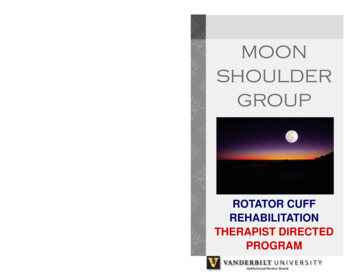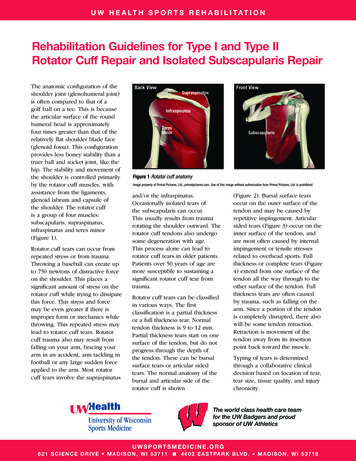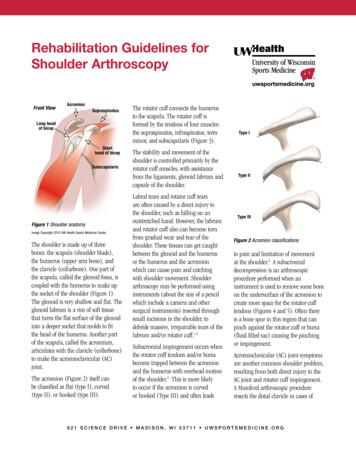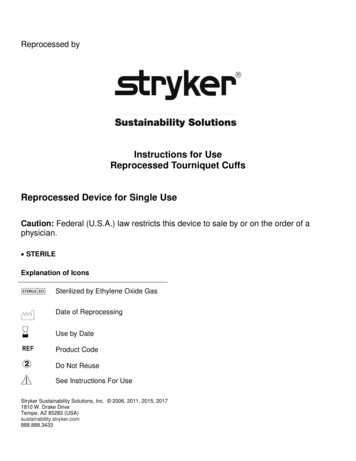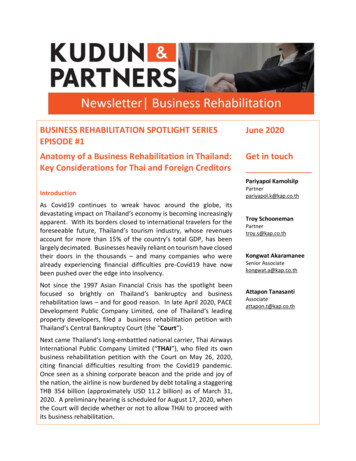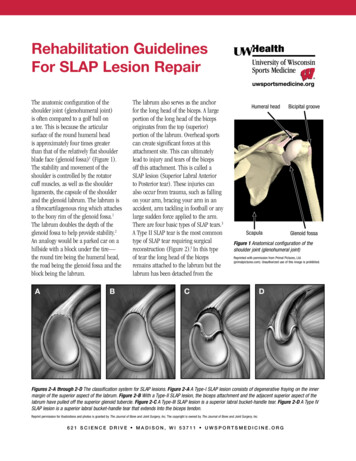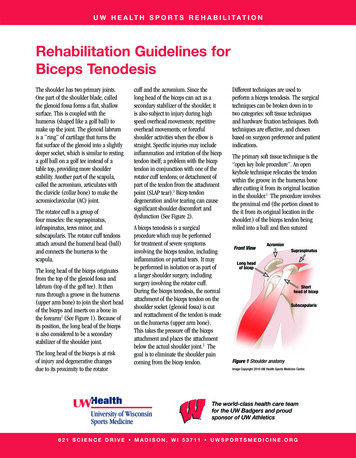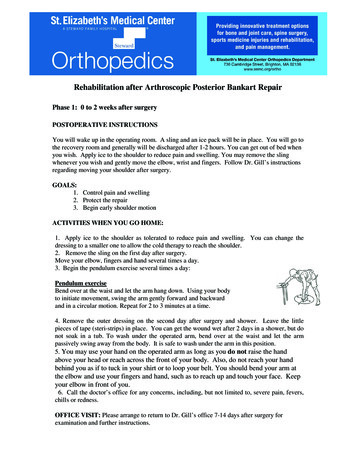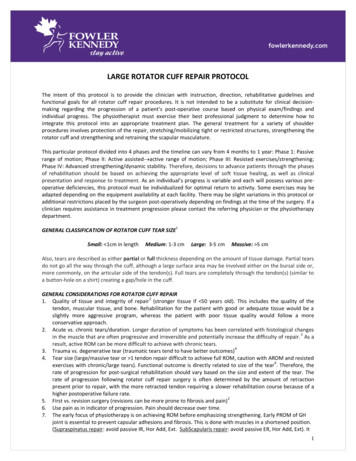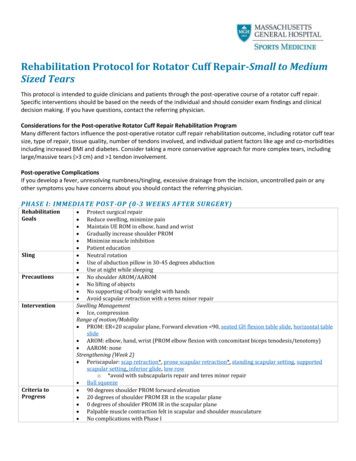
Transcription
Rehabilitation Protocol for Rotator Cuff Repair-Small to MediumSized TearsThis protocol is intended to guide clinicians and patients through the post-operative course of a rotator cuff repair.Specific interventions should be based on the needs of the individual and should consider exam findings and clinicaldecision making. If you have questions, contact the referring physician.Considerations for the Post-operative Rotator Cuff Repair Rehabilitation ProgramMany different factors influence the post-operative rotator cuff repair rehabilitation outcome, including rotator cuff tearsize, type of repair, tissue quality, number of tendons involved, and individual patient factors like age and co-morbiditiesincluding increased BMI and diabetes. Consider taking a more conservative approach for more complex tears, includinglarge/massive tears ( 3 cm) and 1 tendon involvement.Post-operative ComplicationsIf you develop a fever, unresolving numbness/tingling, excessive drainage from the incision, uncontrolled pain or anyother symptoms you have concerns about you should contact the referring physician.PHASE I: IMMEDIATE POST -OP (0-3 WEEKS AFTER ntionCriteria toProgress Protect surgical repair Reduce swelling, minimize pain Maintain UE ROM in elbow, hand and wrist Gradually increase shoulder PROM Minimize muscle inhibition Patient education Neutral rotation Use of abduction pillow in 30-45 degrees abduction Use at night while sleeping No shoulder AROM/AAROM No lifting of objects No supporting of body weight with hands Avoid scapular retraction with a teres minor repairSwelling Management Ice, compressionRange of motion/Mobility PROM: ER 20 scapular plane, Forward elevation 90, seated GH flexion table slide, horizontal tableslide AROM: elbow, hand, wrist (PROM elbow flexion with concomitant biceps tenodesis/tenotomy) AAROM: noneStrengthening (Week 2) Periscapular: scap retraction*, prone scapular retraction*, standing scapular setting, supportedscapular setting, inferior glide, low rowo *avoid with subscapularis repair and teres minor repair Ball squeeze 90 degrees shoulder PROM forward elevation 20 degrees of shoulder PROM ER in the scapular plane 0 degrees of shoulder PROM IR in the scapular plane Palpable muscle contraction felt in scapular and shoulder musculature No complications with Phase I
PHASE II: INTERMEDIATE POST-OP (4-6 WEEKS AFTER ntion*Continue withPhase IinterventionsCriteria toProgress Continue to protect surgical repair Reduce swelling, minimize pain Maintain shoulder PROM Minimize substitution patterns with AAROM Patient education Neutral rotation Use of abduction pillow in 30-45 degrees abduction Use at night while sleeping No lifting of objects No supporting of body weight with handsRange of motion/Mobility PROM: ER 20 scapular plane, Forward elevation 90 AAROM: Active assistive shoulder flexion, shoulder flexion with cane, cane external rotation stretch,washcloth press, sidelying elevation to 90 degreesStrengthening Periscapular: Row on physioball, shoulder extension on physioball 90 degrees shoulder PROM forward elevation 20 degrees shoulder PROM ER in scapular plane 0 degrees of shoulder PROM IR in the scapular plane Minimal substitution patterns with AAROM Pain 4/10 No complications with Phase IIPHASE III: INTERMEDIAT E POST-OP CONTD (7-8 WEEKS AFTER ntion*Continue withPhase I-IIinterventionsCriteria toProgress Do not overstress healing tissue Reduce swelling, minimize pain Gradually increase shoulder PROM/AAROM Initiate shoulder AROM Improve scapular muscle activation Patient education Discontinue No lifting of heavy objects ( 10 lbs)Range of motion/Mobility PROM: ER 30 scapular plane, Forward elevation 120 AAROM: seated shoulder elevation with cane, seated incline table slides, ball roll on wall AROM: elevation 120, supine flexion, salutes, supine punch, wall climbsStrengthening Periscapular**: Resistance band shoulder extension, resistance band seated rows, rowing, lawnmowers, robbery, serratus punches **Initiate scapular retraction/depression/protraction with subscapularis and teres minor repair Elbow: Biceps curl, resistance band bicep curls and triceps 120 degrees shoulder PROM forward elevation 30 degrees shoulder PROM ER and IR in scapular plane Minimal substitution patterns with AROM Pain 4/10PHASE IV: TRANSITIONAL POST-OP (9-10 WEEKS AFTER SURGERY)RehabilitationGoalsPrecautions Do not overstress healing tissueGradually increase shoulder PROM/AAROM/AROMImprove dynamic shoulder stabilityProgress periscapular strengthGradually return to full functional activitiesNo lifting of heavy objects ( 10 lbs)Massachusetts General Hospital Sports Medicine2
Intervention*Continue withPhase II-IIIinterventionsCriteria toProgressRange of motion/mobility PROM: ER 45 scapular plane, Forward elevation 155, ER @ 90 ABD 60 AROM: supine forward elevation with elastic resistance to 90 deg, scaption and shoulder flexion to90 degrees elevationStrengthening Periscapular: Push-up plus on knees, prone shoulder extension Is, resistance band forward punch,forward punch, tripod, pointer 155 degrees shoulder PROM forward elevation 45 degrees shoulder PROM ER and IR in scapular plane 60 degrees shoulder PROM ER @ 90 ABD 120 degrees shoulder AROM elevation Minimal to no substitution patterns with shoulder AROM Performs all exercises demonstrating symmetric scapular mechanics Pain 2/10PHASE V: TRANSITIONAL POST-OP CONTD (11-12 WEEKS AFTER SURGERY)RehabilitationGoalsIntervention*Continue withPhase II-IVinterventionsCriteria toProgressRestore full PROM and AROMEnhance functional use of upper extremityRange of motion/mobility PROM: Full AROM: FullStretching External rotation (90 degrees abduction), Hands behind head, IR behind back with towel, sidelyinghorizontal ADD, sleeper stretch, triceps and lats, doorjam series Full pain-free PROM and AROM Minimal to no substitution patterns with shoulder AROM Performs all exercises demonstrating symmetric scapular mechanics Pain 2/10 PHASE VI: STRENGTHENING POST-OP (13-16 WEEKS AFTER SURGERY)RehabilitationGoalsIntervention*Continue withPhase II-VinterventionsCriteria toProgressMaintain pain-free ROMInitiate RTC strengthening (with clearance from MD)Initiate motor control exercise Enhance functional use of upper extremityStrengthening Rotator cuff: internal external rotation isometrics, side-lying external rotation,Standing external rotation w/ resistance band, standing internal rotation w/ resistance band,internal rotation, external rotation, sidelying ABD standing ABD Periscapular: T and Y, “T” exercise, push-up plus knees extended, wall push up, “W” exercise,resistance band Ws, dynamic hug, resistance band dynamic hug Biceps curl (begin with concomitant biceps tenodesis/tenotomy)Motor Control Internal and external rotation in scaption and Flex 90-125 (rhythmic stabilization) IR/ER and Flex 90-125 (rhythmic stabilization) Quadruped alternating isometrics and ball stabilization on wall PNF – D1 diagonal lifts, PNF – D2 diagonal lifts Field goals Clearance from MD and ALL milestone criteria below have been metFull pain-free PROM and AROMER/IR strength minimum 85% of the uninvolved armER/IR ratio 60% or higherNegative impingement and instability signsPerforms all exercises demonstrating symmetric scapular mechanicsQuickDASH/PENNMassachusetts General Hospital Sports Medicine3
PHASE VII: EARLY RETURN-TO-SPORT (4-6 MONTHS AFTER SURGERY)RehabilitationGoalsIntervention*Continue withPhase II-VIinterventionsCriteria toProgressReturn-to-Sport Maintain pain-free ROM Continue strengthening and motor control exercises Enhance functional use of upper extremity Gradual return to strenuous work/sport activityStrengthening Rotator cuff: External rotation at 90 degrees, internal rotation at 90 degrees, resistance bandstanding external rotation at 90 degrees, resistance band standing internal rotation at 90 degreesMotor control Resistance band PNF pattern, PNF – D1 diagonal lifts w/ resistance, diagonal-up, diagonal-downWall slides w/ resistance band See specific return-to-sport/throwing program (coordinate with physician) Last stage-no additional criteria For the recreational or competitive athlete, return-to-sport decision making should be individualizedand based upon factors including level of demand on the upper extremity, contact vs non-contactsport, frequency of participation, etc. We encourage close discussion with the referring surgeon priorto advancing to a return-to-sport rehabilitation program.Revised June 2020ContactPlease email MGHSportsPhysicalTherapy@partners.org with questions specific to this protocolReferencesAmerican Academy of Orthopaedic Surgeons. Management of Rotator Cuff Injuries Clinical Practice Guideline. ed March 11, 2019Chang KV, Hung CY, Han DS, et al: Early versus delayed passive range of motion exercise for arthroscopic rotator cuff repair: A meta-analysis of randomizedcontrolled trials. Am J Sports Med 2014. [Epub ahead of publication]Cuff, D.J., Pupello, D.R. Prospective randomized study of arthroscopic rotator cuff repair using an early versus delayed postoperative physical therapy protocol.Journal of Shoulder and Elbow Surgery. 2012. p. 1-6.Edwards PK, Ebert JR, et al. A systematic review of electromyography studies in normal shoulders to inform postoperative rehabilitation following rotator cuffrepair. JOSPT. 2017. 47 (12): 931-944.Ghodadra NS, Provencher MT, et al. Open, Mini-open, and All-Arthroscopic Rotator Cuff Repair Surgery: Indications and Implications for Rehabilitation. JOSPT2009; 39 (2): 81-89.Kibler, W.B., Sciascia, A. D., Uhl, T. L., et al. Electromyographic analysis of specific exercises for scapular control in early phases of shoulder rehabilitation. TheAmerican Journal of Sports Medicine. 2008. 36(9): p. 1789-1798.Lee, B.G., Cho, N.S., Rhee, Y.G. Effect of two rehabilitation protocols on range of motion and healing rates after arthroscopic rotator cuff repair: aggressiveversus limited early passive exercises. The Journal of Arthroscopic and Related Surgery. 2012. 28(1): p. 34-42.Long Chen, Kun Peng, Dagang Zhang, Jing Peng, Fei Xing, Zhou Xiang. Rehabilitation protocol after arthroscopic rotator cuff repair: early versus delayedmotion. Int J Clin Exp Med 2015;8(6):8329-8338Thigpen CA, Shaffer MA, et al. The American Society of Shoulder and Elbow Therapists’ consensus statement on rehabilitation following arthroscopic rotatorcuff repair. J Shoulder Elbow Surg. 2016. 25, p 521-535.Van der Meijden, O.A., Westgard, P., Chandler, Z., et al. Rehabilitation after arthroscopic rotator cuff repair: current concepts review and evidence-basedguidelines. International Journal of Sports Physical Therapy. 2012. 7(2): p. 197-218.Massachusetts General Hospital Sports Medicine4
Massachusetts General Hospital Sports Medicine5
Hudak PL, Amadio PC, Bombardier C. Development of an upper extremity outcome measure: the DASH (disabilities of the arm, shoulder and hand) [corrected].The Upper Extremity Collaborative Group (UECG). Am J Ind Med. 1996;(6):602-608.Massachusetts General Hospital Sports Medicine6
Massachusetts General Hospital Sports Medicine7
Leggin BG, Michener, LA, et al. The Penn Shoulder Score: reliability and validity. JOSPT. 36 (3): 138-151.Massachusetts General Hospital Sports Medicine8
International Journal of Sports Physical Therapy. 2012. 7(2): p. 197-218. Massachusetts General Hospital Sports Medicine 5 . Massachusetts General Hospital Sports Medicine 6 Hudak PL, Amadio PC, Bombardier C. Development of an upper extremity outcome measure: the DASH (disabilities of the arm, shoulder and hand) [corrected].
